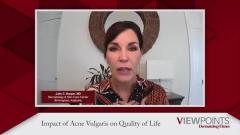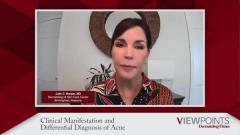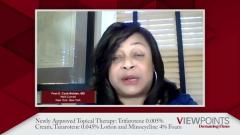
Contributory and Predisposing Factors Influencing Acne
James Q. Del Rosso, DO, comments on the facts and myths surrounding contributory and predisposing factors that influence the development of acne.
Episodes in this series

Hilary E. Baldwin, MD: Why don’t we talk a bit about the diagnosis of acne? Let’s start off with some contributing factors that may be present, like genetic components or perhaps environmental components. Jim, what do you think about that? If a patient sitting in front of you with acne, are there more genetic or more environmental predisposing factors for this particular patient?
James Q. Del Rosso, DO: The patients often think that it’s “environmental” because they think it’s something that they’re doing, something they’re eating, or something they’re using on their skin. A lot of times, it’s the parent though. I hate to say it, but it’s usually a mother. It’s sometimes a father, more so nowadays than in the past, who is implicating it by saying it’s the patient’s diet or what they’re eating or drinking. The patients will sometimes have questions about that. There’s definitely a genetic component to it, but we don’t always see or hear that when I see patients who have more severe acne. Many times, one of the parents or both will have had severe acne at some point. I think about that as a factor, but it’s so common that it’s something that many people are going to go through. How they individually respond to the inflammatory changes that are going on dictates the severity of their response.
Hilary E. Baldwin, MD: Yes. I remember seeing a statistic once, and I looked back and tied to find it again, but it was that severe acne begets severe acne. There is at least some increased incidence of severity in the parents reflecting severity in the child. It is also that adult female acne begets adult female acne. That’s the statistic I can’t find any more. Do you think that’s true in your practice?
James Q. Del Rosso, DO: I remember that, for a lot of the women who have acne, the way that they arbitrarily defined adult female acne years back was 25 years of age and older. With some of the pharmaceuticals that they were trying to target, especially topical agents, they would break it down from adolescents to adults, adults being 18 years of age. It’s not like you’re 17 years and 364 days old, so you have adolescent acne, and now 1 day later, you have adult female acne. If you separate it out, you might say that, for women who are in their mid-20s and beyond and have acne, about 75% of them have the same type of acne that they had as teenagers. A smaller percentage have acne that started when they were in their early to mid-20s or maybe even later, and they didn’t have much acne when they were teenagers.
For a lot of these patients, they have acne, and it just never shut off with a lot of the female patients. There are patients who come in who tend to have that “classic hormonal acne,” which is a term I don’t like because all acne is hormonal. I heard Julie say that this weekend in a talk, and I couldn’t agree more. They have that band, that U-shape type of presentation that’s very inflammatory in nature and not very comedonal.
But a lot of the women who have adult female acne have the typical papules, pustules, and comedones that are on the face above the jawline, and they may also have truncal acne, so I don’t know if that’s totally true.
Newsletter
Like what you’re reading? Subscribe to Dermatology Times for weekly updates on therapies, innovations, and real-world practice tips.























